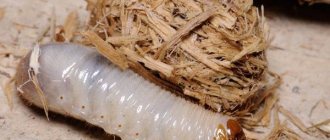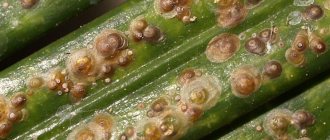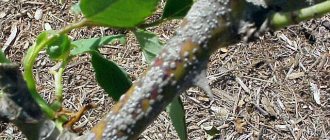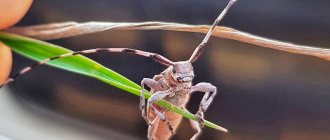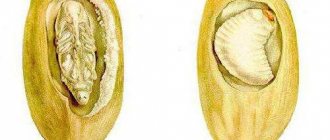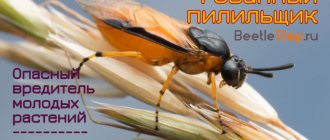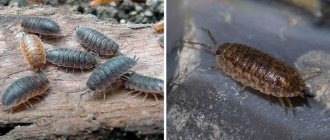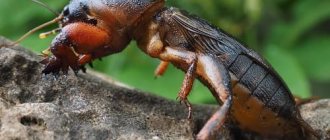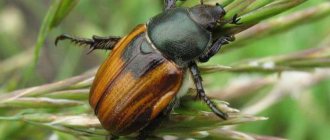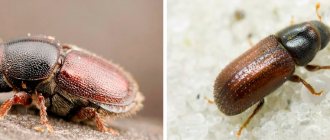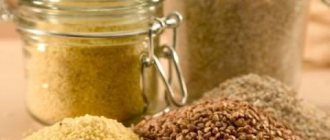Home is the place where a person feels most safe from any threats. However, it happens that unexpected guests in the form of parasitic insects enter your home. Therefore, the discovery of a bean weevil in the living room naturally causes a feeling of discomfort, fear, horror and disgust for many. However, it is necessary to find out the reason for the sudden appearance of bugs in the house and effectively get rid of them.
Description and types of pest
All grains belong to the order of beetles.
The habitat is quite wide: weevils are found in Europe, Asia, North and South America. There are more than 1,000 species in nature, about 90 are found in Russia. However, not all weevils are classified as agricultural pests; many prefer to settle on wild plants. Despite the name, weevils have nothing to do with cereals; they prefer legumes, umbelliferous, and bindweed species.
Depending on the species, the size of adult grains varies from 1 to 22 mm. The body is covered with small hairs that form blurry spots. The color of the elytra is light gray, brown, brownish, the body is usually black. The larvae are thick, legless, and white.
Insects are thermophilic, active only in bright sunlight. The larvae develop inside grains (beans, beans, peas).
Pea: features
This type of beetle prefers to parasitize peas, occasionally moving to other legumes, mainly wild ones. You will not find it on beans, legumes and other cultivated representatives of the family.
The pea weevil is very small, the length of an adult insect does not exceed 5 mm. Beetle activity begins in the spring. At first they feed on the pollen of early weeds from the legume family, but with the beginning of pea flowering they move to the plantings. When the pods appear, the females lay a small, transparent white egg in each.
The larvae develop as the pea grows. When the peas ripen, the grown caterpillar penetrates one of them, gnawing a small cave. Here it completes its development, feeding on the pulp of the pea. There the larva pupates, turning into a beetle. After harvesting, infected grains end up in warehouses and barns, where insects overwinter.
Beans: main differences
The bean weevil is considered more dangerous than the pea weevil: it threatens several types of legumes at once.
The risk zone includes:
- all types of beans;
- peas;
- beans;
- rank;
- lentils;
- Vika;
- chickpeas;
- soybeans
The adult insect is smaller in size than the previous species - no more than 4 mm in length. The upper wings are dark brown, with longitudinal light spots. The insect develops in the same way as the pea weepsilon, but the fertility of the bean weevil is much higher. The female lays up to 20 eggs in each bean, and during the season their number reaches 100.
Small larvae can parasitize one pea or infect several at once. At the same time, adult beetles that ended up in storage along with the collected pods can continue to reproduce. The cycle of generational change does not stop; as a result, by spring the entire stock of beans, peas or lentils may be infected.
Where do insects come to us from?
Many housewives who carefully keep their house clean often wonder: why are there bugs in the beans? Most often, insects appear due to the fact that sanitary standards are poorly observed in factories. Such consequences can be caused by neglect of heat treatment and violation of storage rules. This is why beans sold in stores may initially contain pests.
Beetles can also appear in beans by moving into them from neighboring products. Most often, bugs move into beans made from flour and starch.
Sources
- https://apest.ru/nasekomye/fasolevaya-zernovka/
- https://KuhniClub.ru/uhod/zhuchki-v-krupe.html
- https://MoeFermerstvo.ru/fasol/chto-delat-esli-zavelis-zhuchki
- https://atmagro.ru/2017/10/23/vrediteli-fasoli-s-foto-i-metody-borby/
- https://DachaMechty.ru/fasol/chto-delat-zavelis-zhuchki.html
[collapse]
What is the danger of their appearance?
Pea and bean grains can destroy up to 40% of the crop.
If infected beans are placed in a general storage, by spring you can lose the entire supply: overwintering beetles will continue to lay eggs, and developing larvae will eat the beans from the inside.
The taste of damaged peas or beans deteriorates. Eating peas infected with larvae is simply dangerous: traces of the life activity of the caterpillars remain inside. It is also not worth sowing such material: the germination rate of infected seeds is low, and there is a risk of introducing pests into the soil and provoking a new wave of infections.
Peculiarities of bean seed propagation
Under natural conditions, bean grain propagation occurs during fruit ripening. The female gnaws a hole in the seam of the bean and lays 15-20 white oblong eggs in it. The length of the embryo does not exceed 0.2 mm. The fertility of one female varies from 60 to 200 eggs. The weevil beetle is quite fastidious and its reproduction is possible under appropriate conditions:
Bean grain
In the warm season, embryo development lasts 7-14 days, at lower temperatures 35-40 days. The hatched bean kernel larvae penetrate deep into the bean and then into the grain itself. Newborns have 3 pairs of legs, are distinguished by mobility and the presence of bristles. Several dozen larvae can simultaneously coexist in one bean seed; they eat the contents of the bean and gnaw tunnels in it. The larval maturation stage lasts 3 weeks and ends with pupation.
The young beetle easily gnaws a hole in the bean and leaves it. The full development cycle of the weevil ends in September and October, and most often the larvae enter the storage with the harvest.
In field conditions, the female gives 2 generations, in the southern regions 3-4. In heated rooms, under favorable conditions, insects breed year-round.
Prevention measures
When fighting weevil, special attention is paid to preventive measures.
It is necessary to carefully select planting material, giving preference to early ripening varieties. They manage to bloom and form pods before the maximum activity of the weevil. It is important to buy only proven planting material. The infected one has low germination rate, and there is a high risk of introducing insects into the field or garden.
The presence of larvae is indicated by small dark holes on beans and beans. Preplanting seed preparation with a bio-insecticide will help reduce the risk of infection.
An important point is the storage of the harvested crop. In industrial conditions, regular professional treatment of barns and other storage facilities is necessary: cleaning, drying, disinfection.
At home, beans, peas and beans should be stored in tightly closed glass or metal containers. Storing legumes at a low temperature, for example, on a glazed balcony, will help prevent the proliferation of grains.
After harvesting, you need to remove tops, leaves and other debris as quickly as possible. It can become a shelter for surviving beetles, which become more active with the first days of spring. Plowing the soil in the fall and deep harrowing in the spring will help reduce the risk of infection. It is important to get rid of weeds and wild grasses in a timely manner: they serve as food for pests before cultivated legumes begin to bloom. Representatives of the same plant family pose a particular risk: meadow chin and acacia.
Radical ways to get rid of bugs
Primitive measures will allow you to get rid of this unpleasant “neighborhood”: heating the cereal in the oven, soaking it in a saline solution before cooking. In this case, black insects will quickly float to the surface, and it will not be difficult to remove them. If there is a large percentage of damage to the product, it is better to get rid of the cereal.
For preventive purposes, the following steps are taken:
- Surviving cereals are stored in airtight bags or tightly closed containers.
- Treating the jar with soapy water and then drying it will help get rid of insects and larvae.
- Inspect other products for signs of pests.
- Affected cereals are placed in the freezer compartment of the refrigerator.
- Treating all surfaces with a soapy solution will help get rid of the subsequent appearance of pests, after which tables, cabinets and window sills are wiped with a 9% vinegar solution.
- Treat cracks and possible penetration points with boiling water.
How to fight
Pest control can be divided into several stages:
- pre-landing preparation;
- spraying with insecticides before flowering;
- repeated processing until pods form;
- disinfection of storage facilities.
The gardener's task is to prevent the females from laying eggs in the pods. If this happens, you can act on the larvae, which remain on the surface of the pods for some time after hatching. Once the peas get inside, they become invulnerable until they get out.
Folk recipes
Traditional methods are suitable for combating weevil in small private farms. Their effectiveness varies; measures to prepare seed material are especially helpful. To combat large colonies of beetles, it is recommended to use insecticides.
The following methods are suitable for treating seeds before sowing:
- Place the sorted grains in a saturated saline solution (1 kg of salt per 3 water) for 1 hour. This treatment will destroy the eggs or larvae.
- Soak peas or beans in a solution of boric acid (1 g per 5 liters of water) for 5-7 minutes.
- Freeze the planting material by placing it in the open air (at sub-zero temperatures) for 3 days or leaving it in the freezer of the refrigerator. The larvae are sensitive to cold and die quickly.
- Treat the grains with a weak solution of an insecticide that affects eggs and larvae.
If the grains are intended for food, they should not be sprayed with pesticides. Preventative freezing or heating in the oven at a temperature of about 60 degrees is suitable.
In industrial conditions, peas or beans are sprayed with chemicals or fumigated before sowing.
Expert opinion
Mityuk Stefania Bogdanovna
Treatment of plantings with various decoctions and infusions based on herbs, tops, onion peels or soap is weakly effective against weevil. For spraying, it is better to use safe and low-toxic bio-insecticides.
Bio-preparations
Products based on fungi or bacterial strains. They are characterized by low toxicity and are safe for people, pets, birds and bees. Can be used for processing planting material and spraying throughout the life of plants. The last treatment is carried out no later than 3 days before harvesting.
Among the most popular drugs in this group:
The drugs are supplied in the form of concentrated solutions or liquids. They are diluted with water in accordance with the instructions on the package and sprayed on the plantings at intervals of 1 week, starting from the moment buds form on peas and beans. During the season, 3-4 treatments can be carried out. The compounds quickly decompose in the soil and do not pollute water bodies.
Bio-products have a significant disadvantage: bacteria and fungi can die at elevated temperatures or hot sun. It is better to process plantings in warm, windless weather. The compositions are absorbed from the leaves and stems within 2 hours and act for several days.
Chemicals
What methods of combating weevil do you use?
FolkChemical
Among the drugs recommended for exterminating pests in garden plots, there are no products aimed specifically at combating weevil. Complex action formulations that are used against pea moths and various types of aphids are suitable. The principle of action is similar: once on the body or in the digestive system, the active substances paralyze the insect or cause rapid changes in the intestinal tract, leading to death.
Chemicals are effective against adult beetles and larvae, but have little effect on eggs. Intestinal or contact-intestinal type insecticides work best. Preparations of weak and moderate toxicity are used on personal plots; stronger pesticides are allowed for treating agricultural fields.
Among the most effective means:
Intestinal insecticide, the main active substance is thiamethoxam. Designed for spraying during the growing season. Consumption of aqueous solution is 200-400 liters per hectare. Can be used in fields and private gardens, toxicity is average. Spraying is carried out during the flowering period and repeated after the formation of pods. The efficiency is high, insects die at all stages of development. Valid for up to 20 days after spraying.
Contact-intestinal insecticide against all types of leaf-gnawing and leaf-sucking insects. The active ingredient is zeta-cypermethrin. Quickly destroys pea moths, aphids, bean and pea weevils. Spraying is carried out during the growing season in 2-3 doses, the consumption of the aqueous solution is standard - 200-400 liters per hectare. The drug is odorless and safe for humans and pets, but may be harmful to bees.
A composition based on cypermethrin quickly destroys the pea codling moth and all types of grains. Very toxic to insects, safe for animals and humans. Can be used for pre-planting treatment and spraying during the growing season. Working fluid consumption is from 200 liters per hectare; re-treatment is required after 7-10 days.
Insecticide of contact-intestinal action from the group of carbamates. Effective against all types of legume pests; after spraying, it protects plants for about 30 days. Has a slight sulfur odor, moderate toxicity. The drug quickly decomposes in the sun and at elevated temperatures.
Complex preparation of contact-intestinal type. Very economical - to treat 1 hectare you will need no more than 300 liters of aqueous solution. The main active substance is dimethoate in combination with beta-cypermethrin. Suitable for spraying plantings during the growing season; at least 2 treatments are carried out per season with an interval of 7-10 days. It acts especially quickly on larvae in all stages of development.
Bean and pea weevils are pests that can greatly reduce the yield of agricultural fields. They are also dangerous for personal households. Control of planting material, timely processing of plantings and proper storage of legumes will help get rid of voracious insects.
Protection measures
To protect plants from these diseases, it is necessary to get rid of pests, which often become their carriers. You should also provide optimal growth conditions for plantings and maintain humidity at the required level.
Preventive
If a summer resident is afraid that the beans will be affected by pests, he should prevent their occurrence. Most often, it is enough to use folk remedies that recommend covering the soil around the plants with dried nettles. You can also water the plantings with garlic broth, which will also repel pests.
Barn mites
Among Acariformes, the families of flour (grain) mites (Acaridae) and hairy mites (Glycyphagidae) are of the most economic importance. These are large families that include stock pests of various species.
Most often polyphagous.
The most common species of the family Flour (grain) mites (Acaridae): Flour mite (Acarus siro), Rodionov's mite (Caloglyphus rodionovi), Black-legged mite (Aleuroglyphus ovatus), Elongated mite (Tyrophagus putrescentiae) - quickly grow in grain and its processed products. They spread from place to place with contaminated grain products and other means.
Ways to preserve the bean harvest for the winter
A convenient way to preserve the harvest of green beans is to freeze the green pods or can them. Special conditions are created for storing grain varieties. In the room where bean grains are stored, the air temperature is maintained at +10 degrees, and the humidity should be no more than 50%. In such conditions, insects are not able to survive.
Before being sent for storage, the grain bean pods are dried outside under the sun. To do this, they are laid out on a flat surface or hung in bunches under a canopy. After complete drying, the pod doors open slightly. Then the bean grains are extracted and subjected to heat treatment. The grains are heated in the oven at a temperature of +90 degrees. After such treatment, the beans lose their ability to sprout. Therefore, it is only suitable for consumption.
Shelled beans are placed in jars with tight-fitting glass or tin lids. Polyethylene lids are not used because they do not provide sufficient tightness. You can use linen bags made of natural fabric to store grains. Then, before planting the crop, they are soaked in a strong salt solution to protect them from insects.
What damage do beetles cause?
The beetles do not attack people or bite, but they cause significant harm to humans. Infection of plants leads to a decrease in yield. The bean weevil begins to harm plants even at the stage of their growth, damaging early crops. There have been cases where the bean yield was reduced by 70%. In addition to beans, insects are not averse to eating chickpeas, soybeans, and peas. The photo shows beans damaged by beetles.
The larvae eat away nutrients from the grains and fill them with their waste products, which makes the beans unsuitable for sowing and consumption. The entry of infected beans into storage jeopardizes the safety of the entire crop.
The article was compiled using the following materials:
Beklemishev V.N.
Key to arthropods harmful to human health. - M.: MEDGIZ, 1958. - 420 p. 2. Bondarenko N.V., Polyakov I.Ya., Strelkov A.A. Harmful nematodes, mites, rodents. – L.: branch of the publishing house “Kolos”, 1969. – 272 p. 3. Ganiev M.M., Nedorezkov V.D., Sharipov Kh.G. Pests and diseases of grain and grain products during storage. – M.: KolosS, 2009. – 208 p. 4.
Derbeneva-Ukhova V.P. Guide to medical entomology. Ed. V.P. Derbeneva-Ukhova. M., “Medicine”, 1974, 360 p.
5.Eremenko V.M., Brudnaya A.A., Menshova L.P., Ratanova V.F., Solodovnik P.S., Sosedov N.I. Guide to Pest Control for Grain Stocks. – M.: Kolos, 1967. -336 p. 6.
Zhantiev R.D. Carpet beetles (family Dermestidae) of the fauna of the USSR. – M.: Moscow University Publishing House, 1976. – 182 p.
7. Zagulyaev A.K., Moths and moths are pests of grain and food supplies. – M – L.: Nauka, 1965. 8.
Rylnikov V.A. Managing the number of problematic biological species: Textbook / ed. V.A. Rylnikova. – M.: Institute of Pest Management, 2012. – In 3 volumes. T. 2. Disinsection / A.A. Zharov. – 2012. – 169. p.: ill.
9.
Sokolov E.A. Pests of stocks, their quarantine significance and control measures. – Orenburg: Printing House “Dimur”, 2004. – 104 p., ill.: 28 p.
10. Shorokhov P.I., Shorokhov S.I. Barn pests and measures to combat them. – M.: State Publishing House of Kolkhoz and State Farm Literature “Selkhozgiz”, 1936. – 382 p. Images (reworked): 11.
Bean weevil Acanthoscelides obtectus, by Clemson University – USDA Cooperative Extension Slide Series, Bugwood.org, licensed under CC BY
12.
False stable fly Muscina stabulans, by Whitney Cranshaw, Colorado State University, Bugwood.org, licensed under CC BY
13.
Khapra beetle Trogoderma granarium 0660007, by Ministry of Agriculture and Regional Development Archive, Ministry of Agriculture and Regional Development, Bugwood.org, licensed under CC BY NC
14.
Yellow mealworm Tenebrio molitor 1233103, by Clemson University – USDA Cooperative Extension Slide Series, Bugwood.org, licensed under CC BY
Collapse List of all sources
Bean diseases
In addition to pests, plant diseases also affect the safety of the crop. Typically, beans are affected due to improper agricultural practices. Then the grains spoil and turn black. In this case, they talk about fungal or viral infection.
The most common diseases of beans:
- Powdery mildew is manifested by the formation of a whitish coating on the surface of the leaf blade. Then the affected parts of the plant turn yellow.
- Anthracnose appears as brown spots on fruits and leaves. Gradually, the leaf blades dry out, and the fruits become covered with burgundy-colored ulcers.
- White rot spreads to the green parts of the bush and fruits. The affected areas of the plant soften and become covered with a white coating. Gradually such a plant dies.
- When infected with root rot, the bean root system suffers. The roots become covered with a pinkish coating and die. The affected plant grows slowly and does not develop.
- Bacterial spot appears as dark spots on leaves and stems. Over time, the affected areas enlarge and merge into a single whole. The affected plant dies after a short time.
- Bean mosaic is characterized by spots on the leaves. After this, the leaf plates wrinkle and wither.
Sanepidemstation.com in the fight against Khrushchak
Pests that have the ability to cause significant inconvenience to humans - flour beetles - can easily be destroyed as soon as possible if you take care to seek the help of professionals. The specialists of Sanepidemstation.com are ready to offer their services for the quick and effective treatment of warehouse, commercial, and residential premises from pests using modern equipment. Spraying drugs using fog generators involves the use of highly efficient technologies.
The visit of specialists allows you to achieve maximum effect in pest control and gives pronounced results within the first few days after the treatment. The cost of treating apartments and houses with insecticidal agents against flour beetles depends on the area of the objects. Chemicals are sprayed under high pressure, creating fine dust that penetrates into the most inaccessible corners of the space.

